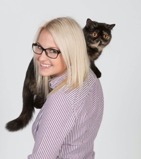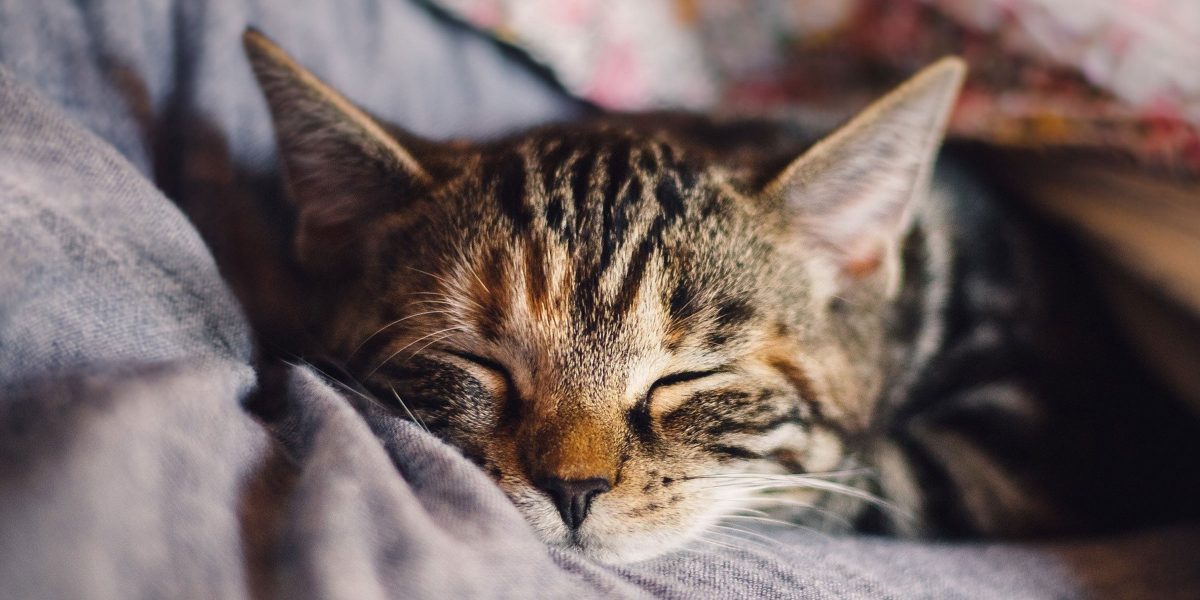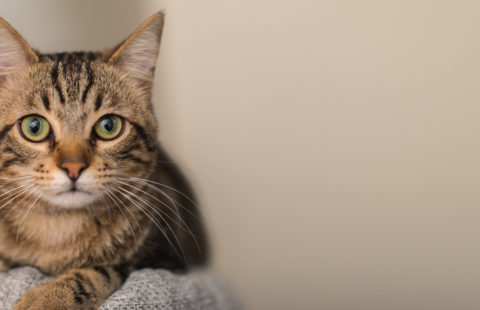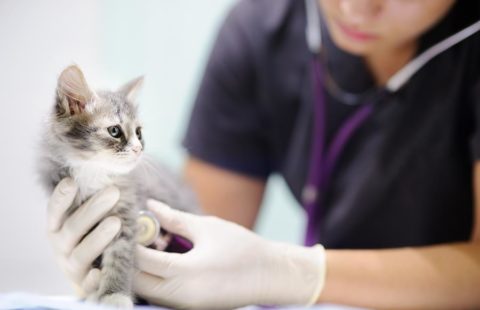This week, ‘Spotlight on Science’ features multi-talented Dr Petra Cerna, a veterinarian, breeder and researcher from the Czech Republic, currently working in Scotland.
Petra tells us more about herself, her research into the motivation of owners to purchase pedigree cats, with specific focus on the acquisition of brachycephalic cats and what she likes about iCatCare!

MVDr. Petra Cerna MRCVS
Petra, tell us a little more about yourself
I received my veterinary degree from the University of Veterinary and Pharmaceutical Sciences, in Brno (Czech Republic). I moved to Scotland just after my graduation to do a Small Animal Rotating Internship at Vets Now Referral Hospital in Glasgow. I am currently working as a Small Animal Medicine Intern at the University of Edinburgh while also doing a part-time Ph.D. at the University in Brno looking into the genetic predisposition of different breeds to Feline Infectious Peritonitis; I am also looking at the prevalence of hip dysplasia in pedigree cats.
I have been showing and breeding British Shorthair cats under the prefix Royal Angel since 2006, and in 2014 I became a FIFe International Judge. FIFe is an International Cat Federation for those breeding and showing cats. It’s clear working with pedigree cats and breeders is an important part of my life which I enjoy very much. Working as a vet, breeder and judge allows me to really help improve the welfare of pedigree cats, especially in respect to their physical health.
What was your inspiration for the study?
Cats are very popular pets worldwide and pedigree cats are increasingly prevalent, with brachycephalic breeds being some of the most commonly registered breeds. A brachycephalic breed is one with a shortened muzzle and flattened face such as the Persian cat. There are widely publicised growing concerns about the physical health and, ultimately, the welfare of brachycephalic dogs due to the severity of the shortening of the muzzle and flattening of the face. Many with such extreme features have problems breathing, eating and with their eyes due to the squashing of the airways, distortion of jaw alignment and bulging eyes and eyelid abnormalities. Recent studies are raising the awareness of similar problems in brachycephalic cats whose flattened features are becoming more extreme. However, few studies have investigated the reasons behind why people purchase specific types or pedigree of cats, including the brachycephalic breeds.
What was the aim of the study?
We wanted to understand how owners decide upon and acquire their cats. We were also interested in whether or not people undertake significant research before buying their cat and whether these things differed between owners of brachycephalic breeds in comparison to owners of other breeds.
How did you conduct your study?
Some of the team had undertaken a similar study with a questionnaire that investigated what motivated people to acquire pedigree dog breeds and how they went about getting them, so we adapted it for cat owners. It was designed to gather information on owners’ motivation, perceptions, behaviour and knowledge prior to, during, and after acquiring their cat. We split the owners into three groups:
1) Owners of non-pedigree cats
2) Owners of pedigree cats (excluding extreme brachycephalic breeds such as Persian and Exotic Shorthair)
3) Owners of extreme brachycephalic breeds (Persian and Exotic Shorthair cats)
We asked the participants (owners) different questions about themselves, such as country of residence, their age, and whether they were first time cat owners. We also asked questions about their cats, such as type/breed, age, gender, and neutering status. Then we wanted to find out about their reasons and motivation for acquiring their type of cat (e.g. appearance, popularity, behaviour, health), general motivation for acquiring a cat (e.g. for companionship, for breeding), their pre-purchase research and knowledge, how the cat was acquired (e.g. through charity organisation, breeder) and their behaviour at acquisition (e.g. asking to see health records, seeing the cat’s parents/siblings). Last, but not least, we were also interested in owners’ satisfaction with their cat (whether they would recommend the type/breed of their cat to others) and the cat’s health and owners’ perception of their welfare.
What were your main findings?
We found several differences between the different groups of owners, such as:
- more non-pedigree cat owners were first-time owners compared to pedigree cat owners (regardless of the breed being brachycephalic or not).
- owners of pedigree cats were more likely to conduct research prior to the acquisition of their cat, compared to non-pedigree cat owners.
However, a key finding is that owners of the mentioned brachycephalic breeds did this less than owners of other pedigree breeds. Moreover, the owners of the brachycephalic breeds were less likely to consider their cat as healthy (especially related to eye and skin conditions, although still giving a generally high score) and were less likely to recommend a brachycephalic cat to others. This suggests that the owners have some awareness of their cat’s health problems. However, from my professional experience, I know some owners of extreme brachycephalic cats (and possibly other pedigree owners) are not fully aware of the potential health problems of their cats and/or underestimate their severity with which they can negatively influence their cats’ health and thus its welfare.
Our study highlights the need to educate owners, breeders and veterinary professionals about responsible pet cat acquisition, conscientious breeding, brachycephalic related disorders and cat welfare.
Was there anything that surprised you?
Although brachycephalic and other pedigree cats are well represented in social media and are celebrity favourites, media exposure did not appear to play as significant a role when influencing the purchase of brachycephalic cats, as it does with brachycephalic dogs. This surprised us as a similar study on dog ownership found that owners of brachycephalic dogs tend to be younger and more likely to be influenced by social media into buying a brachycephalic breed of dog.
What would be your top tips from the results of your study and who would they be for?
The finding that many owners of brachycephalic cats wouldn’t recommend the breed they purchased themselves suggests a lack of awareness around the breed at pre-purchase. I actually own a gorgeous Exotic myself whose brachycephalic features are not so extreme that they impact on her health. She is a healthy individual and demonstrates the wonderful temperament they can have. However, it is vital we educate people to avoid choosing those individuals whose brachycephalic features have become extreme as health risk is high for those cats. By voting with their feet and only selecting those healthy individuals in the breed, owners can encourage breeders to only breed healthy individuals, and to avoid the movement to continually shorten the muzzle and flatten the face.
Thus, my top tips would be based around educating prospective cat owners on the responsibility they have for the quality of life of the cat the minute they become its owner. That education also includes understanding the type/breed of cat they would like to have as different breeds will differ in temperament, time and cost of maintenance and making sure the organisation or breeder they would like to get their cat from has had the cats welfare at its centre through all its different aspects of work, eg, breeding, socialisation, physical health.
I believe increasing the pre-purchase knowledge of different types/breeds of cats would decrease the number of abandoned cats in the world.
Where do you hope the results of this study take you next?
We are currently working with my mentor, Prof. Danielle Gunn-Moore, on further studies looking into Feline Brachycephalism and we very much hope that we can improve the health and welfare of brachycephalic cats as well as to try and find out how owner behaviour during cat acquisition may be improved in line with best practice, especially regarding irresponsible and potentially harmful acquisition methods, such as purchasing them from websites without visiting the breeder and seeing the kitten´s parents and siblings .
It’s clear your research tackles issues with the aim of improving the welfare of cats but do cats feature anywhere else in your life?
Cats have been a big and important part of my life for almost 15 years now. I was studying law in the Czech Republic, but my love for cats made me change my career and decide to study veterinary medicine with the dream of becoming a Feline Specialist one day. I enjoy working with breeders and my breeding background gives me an important understanding of the challenges that cat breeding brings but also motivation to improve the health and welfare of pedigree cats. I have two beautiful British Shorthairs now, and an Exotic Shorthair called Bellina, who is the love of my life. The temperament of Persian and Exotic cats is amazing, and I understand why these breeds are so popular from a behavioural perspective. However, we need to realise that lot of work needs to be done in order to make sure these and other brachycephalic breeds will be as healthy as possible and their quality of life and welfare is not compromised. Within a breed, there will be variations between individuals in the extremity of physical features and it is vitally important, those with such exaggerated features that compromise welfare are excluded from any breeding programs.
What’s your favourite thing about iCatCare?
I have been following iCatCare ever since I started studying veterinary medicine and I am also an ISFM member (The International Society of Feline Medicine is the veterinary division of iCatCare). I admire the dedication of iCatCare to improve the health and mental wellbeing of all cats all over the world, and to make everyone aware of what special creatures cats are, understanding their unique behaviour and needs. ISFM provides excellent education to veterinary professionals and I very much enjoy their courses. For example, the ISFM Advanced Certificate in Feline Behaviour made me understand cats and their behaviour in much more depth in order to give them the attention and care they deserve both as a vet, breeder and an owner.
Reference: Plitman, L., Černá, P., Farnworth, M. J., Packer, R., & Gunn-Moore, D. A. (2019). Motivation of owners to purchase pedigree cats, with specific focus on the acquisition of brachycephalic cats. Animals, 9(7), 394.
Want to learn more?
Petra highlights in her top tips that cats differ in their temperament and behaviour. You might want to go back and visit our first Spotlight on Science piece on heritability of behaviour if you haven’t read it yet.
Petra also mentions our ISFM Advanced Feline Behaviour for Veterinary Professionals. If you would like to learn more about this course, click here. Our next course starts on 7th October 2020 but enrolment is open now.
Let’s put Petra’s top tips into action!
Petra highlights how important it is to do your research before acquiring a cat. There are a few ways we can help you with this!
Start by reading our information packed advice here.
If you are thinking specifically of a kitten and are at the stage of contacting a breeder or rescue organisation to enquire about one, familiarise yourself with The Kitten Checklist. This checklist will help you ask the right questions to make sure the kitten you are interested in is physically healthy, has good mental wellbeing and has the traits required to make it a happy, healthy friendly pet.






